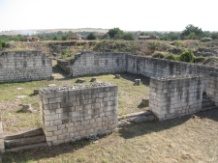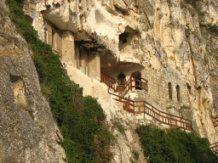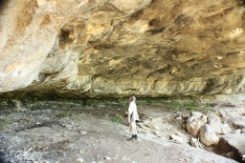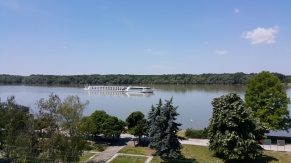

Yatrus or Yatar – the ancient name of the river Yantra. Yatrus is a deity of Thracian mythology, we do not know much, except that it has held several subordinate elements. One theory newer Yantra is a word of Eastern origin: mystical figure who personifies the complex movements of nature. Roman and early Byzantine city with the same Name existed at the mouth of the Yantra River, near the village nowadays, Krivina, Ruse county. It existed until the early seventh century, crushed under the blows invasion of north-eastern Slavs and Avars prabulgarilor. On its ruins, centuries VIII – XIII, there was an Old Bulgarian settlement. Yatrus occupies an area of approximately 3 hectares. It was prtejat a massive stone wall with towers protruding. In 1958 fist discovered west gate, public and private buildings, two old Christian basilicas and others. Found Iron swords, pottery, gold coins from the tenth century, iron tools, and more.
Yatrus’s name meets century Roman road maps III. There has been marked as Yatrus road station, located at the end of a military road which linked Singidunum (today Belgrade) of the Danube River delta. In “Tabula Peutingeriana” Yatru is located nine miles Roman Nove (today near the town of Svishtov) and 16 miles Trimamium (near the village Mechka).
Karel Skorpil was the first to identify the ruins near the village today, Krivina, with Yatrusul novel. Location was confirmed by Bulgarian-German archaeological long. Thanks to their Yatrus was turned into the best researched late Roman military camp in Bulgaria today. It discovered the existence of a settlement and older peredecesor the late Roman city. The settlement worked with Station Road in centuries II – III and probably juact a role in border defense empire.
Between 270-275, under pressure from advancing from the north and northeast of the barbarian tribes, the Romans were forced to leave the province of Dacia north of the Danube. Thus, the inferiorr the river was transformed again into the frontier of the empire. To defend its efficient End Roman emperors staged large-scale construction of cities. This phenomenon has been particularly intense in the fourth century – Ib Emperor Constantine (306-337). In those days, the maul as the Yantra River at its mouth, was built a military camp – the castle, called with the ancient name râulu – Yatrus.
Yatrus Castle is located on a small mound that rises above the marshy mouth of the river Yantra. The place is naturally protected by steep slopes to Nordli northeast. Fortress follows the contours of the hill, which establishes and irregularly shaped. The width of the fortress wall in various sectors is 3 – 3,50 m and its presumed height was 10 m. On the wall are arranged exterioarăa 10 towers resistant, massive, U-shaped, two of them wearing only defends the castle. Yatrusului defense system kernel is a large rectangular tower, which according to its impressive size (30.50 x 15.30 m) is no analog among Roman monuments military construction in the Bulgarian lands today.
Latest archaeological studies indicate that, in this form, Yatrus military camp lasted until the 70 century IV. After the Battle of Adrianople (now Edirne) in 378, which killed the Roman emperor Valens, began an accelerated degradation aa model late Roman military organization in which military camps existing slowly turns into civilian settlements fortified . This process is well seen in the castle Yatrus. After a devastating fire, buildings for exclusive military were abandoned. Instead they formed some smaller size and weaker construction in terms of the art building, whose residents – probably Gothic federates, are a population that deals with agriculture. These complexes have living spaces, storage and work, where they found various instruments and tools trades. Separate findings such as weapons and imported amphorae indicate exitenţa of centralized deliveries. Yatrus remains a defensive unit general border of the empire and its inhabitants to fulfill military tasks during enemy attacks. Only after devastating Hun invasions in the second quarter of the fifth century, the transformation of its military camp in the civil settlement was finalized.
Hune invasions of the fifth century and left their mark on the historical development of the Roman Empire. Counties stretched on the Danube were devastated and depopulated. Not until the time of Emperor Anastasius (491-518) in the lower Danube regions, it has produced a relative calm. Roman authorities participated in the restoration of old cities. Yatrus was built very little, inhabited by a population with modest lifestyle. This settlement became the victim of a fire consuming – in the period after 518, probably invaders, Marcellinus Comes according to ancient writers were Bulgarians. Lately the settlement Yatrus refers to the leadership of Justinian I (527-565). The settlement shared the fate of celorllalte fortifications all along the lower Danube and Avars and Slavs died under lovituriel in the late sixth century. Last time, it was mentioned Teofilact Yatrus Simoca in connection with events in the year 600, after which he disappeared from the pages of history.
A few decades after the final disappearance of Yatrusului Byzantine ruins it appeared a small village inhabited by farmers. After moving national-political center of Bulgarian lands south of the mouth of the river Yantra, it has been assessed and there was established a military garrison. In centuries IX – X century civil apăut and large, probably with two floors. One such building was discovered in tezarur 45 Byzantine coins of gold (solid), which talks about economic opportunities by increasing population of that old Bulgarian settlement. Aprodus end of the settlement was in the 70s of the Tenth century after a devastating fire. Like other old Bulgarian Danube fortifications, the settlement at the mouth Yantra was conquered and burned the prince of Kiev Svetoslav invasion in Bulgarian lands as a result of the invasion and ensuing bizntince. The only findings indicate that, in the eleventh century, the ruins of Old Bulgarian settlement appeared a settlement PECENEAGA.







